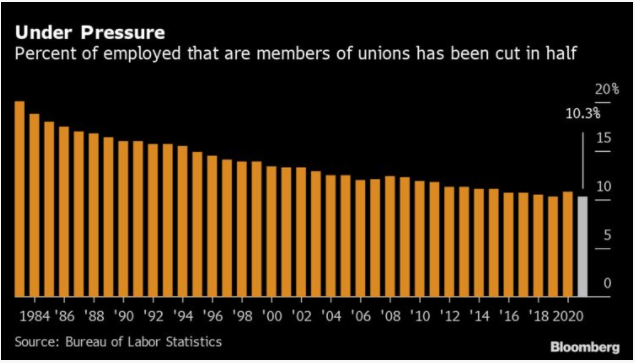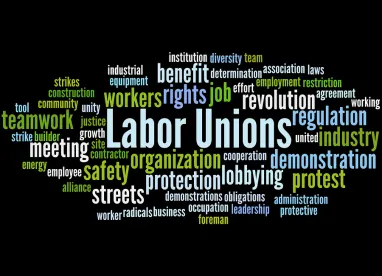It’s late January and you know what that means: the Bureau of Labor Statistics (BLS) has just released its annual report detailing statistical and demographic union rates in America. As in past years, there is a lot of interesting data to unpack.
Bottom line up front: union numbers have declined overall in the past year. According to the BLS press release:
“In 2021, the number of wage and salary workers belonging to unions continued to decline (-241,000) to 14.0 million, and the percent who were members of unions – the union membership rate – was 10.3 percent, the U.S. Bureau of Labor Statistics reported today. The rate is down from 10.8 percent in 2020 – when the rate increased due to a disproportionately large decline in the total number of nonunion workers compared with the decline in the number of union members. The 2021 unionization rate is the same as the 2019 rate of 10.3 percent. In 1983, the first year for which comparable union data are available, the union membership rate was 20.1 percent and there were 17.7 million union workers.”
Here is an informative graphic that shows the decades of decline:

Here are some more key data points from the BLS report:
-
Public-sector worker unionization rates (33.9 percent) continued to significantly outpace private sector unionization (6.1 percent) – with the percentage of union workers being 5 times more in the public sector.
-
Workers in the education, training and library occupation sectors have the highest unionization rates with 34.6 percent of all such workers belonging to unions.
-
While women worker unionization rates have climbed in recent years, men still have a higher rate (10.6 percent) as compared to their female counterparts (9.9 percent).
-
When looking at workers in individual states, Hawaii and New York continued to have the highest unionization rates at 22.4 percent and 22.2 percent, respectively. Conversely, South Carolina and North Carolina continued to have the lowest union membership rates at 1.7 percent and 2.6 percent, respectively.
Does that mean organized labor is in dire straits? Not likely. We saw several high profile strikes in 2021 that garnered a lot of interest and media attention. On the heels of that, we also saw unions score some major organizing victories, such as at Starbucks in Buffalo, New York. In fact, more than a dozen union election petitions have been filed at other Starbucks locations since the election in Buffalo, with many more projected to be in the pipeline. We’ve also seen an uptick in worker unrest and union interest at ecommerce warehouses and facilities. That a union-free stalwart like Starbucks fell last year may be a sign of momentum for unions in their drive to gain more members. All this happened in a year in which we saw public approval of unions continue to increase, topping the highest point in more than half a century.
We also saw unions attempting to adapt with fundamental changes of their own. The Teamsters elected a reform-minded candidate as its top leader who promised a more aggressive labor relations strategy, including more strikes, less cooperative bargaining, and a strategy focused at some of the country’s largest companies.
Finally, the National Labor Relations Board under the current administration likely will be making labor law changes that will make it easier for unions to organize workforces. In short, while unions may be down, they certainly aren’t out – and non-union employers should beware.



 />i
/>i

